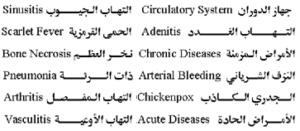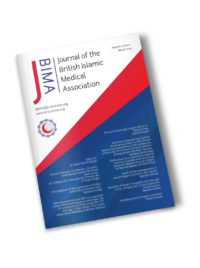
Abstract
In 1903, Sultan Abdul Hameed the second issued an executive order to establish the Ottoman Medical School in Damascus. Official inauguration took place on August 31 of the same year at al-Salhia street in Damascus. Actual teaching began two months after the inauguration.
The purpose of this paper is to spread light on the various stages this school went t rough since its inception, and to reveal its important role in graduating so many physicians and pharmacists, in addition to the founding of the Arabic Medical School of Damascus, and the usage of Arabic language in teaching medical sciences up to date.
Introduction
Before talking about the Ottoman Medical School of Damascus, I would like to briefly mention the two medical schools of Turkey during the nineteenth century, as many Syrian physicians were graduated from, then worked at the Arabic Medical School of Damascus
1.The Military Shahanian School for Medicine and Pharmacy. Teaching began at this school in 1827, and it was in French until 1880 when it changed to Ottoman Turkish
2. The Civilian Shahanian School f r Medicine and Pharmacy. Founded in 1836, teaching began in French, then in 1866 it became in Ottoman Turkish. Since 1876 until 1900 (for 25 years) 584 physicians and 442 pharmacists graduated, belonging to many religions and nations including many Syrians, such as: Ahmad Rateb., Reza Said, Sadek Tarabishi, Taher Gazaeri, Abdul Kader Serri and Maichael Shamendi
The Ottoman Medical School of Damascus
Since 1897, the Ottoman state decided to establish a number of medical schools in Turkey and in other important cities which were under their rule, as there was a severe deficiency in the number of physicians. Dr. Khayreddin Pasha was commissioned to prepare a comprehensive study, revealing the healthcare situation and its requirements at the regions which the Hegazi railroad line runs.
On January 5 1901, he provided a report that mentioned that this railroad line would create great social and economic developments within the region, requiring the need for many physicians to relocate and live there, so they can tolerate the difficult climate of that area. To achieve this purpose, Dr. Khayreddin Pasha suggested the establishment of a school for medical teaching in Damascus, which would train physicians and pharmacists belonging to that region.
It seems that the thought of establishing a medical school in Damascus was stated by many Ottoman officials. And before Khayreddin Pasha had introduced his report -in view of the fact that in a report of the Shahanian medical society was published on the first of September 1900 on the occasion of the 25th anniversary of Sultan Abdul Hameed 11’s hold on power – the report revealed that a forthcoming school for medical and pharmaceutical teachings will be established in Damascus. This was according to a work plan and an expense estimation which had been agreed.
In this stead, we can also say that the other aim for establishing this school, was to face the American protestant and French medical schools in Beirut, which were founded” in the second half of the nineteenth century for missionary purposes.
On April 3, 1903 Sultan Abdul Hammed II issued an executive order to establish the Ottoman Medical School of Damascus. Official inauguration took place on August 31 of the same year, at Ziver Pasha palace in Salhiya street in Damascus. Actual teaching began two months after the inauguration.
Ziver Pasha palace was a large building, containing many huge halls where chemistry, biology , anatomy and physiology laboratories were equipped for learning, in addition to the teaching halls. Clinic l sessions were taking place at what was called AI-Hameedy or foreigners hospital.
We can say this school was the first medical school in modern terms, which was founded by the Ottomen in the Arabic provinces under their rule.
The Ottoman medical school of Damascus provided both medical and pharmaceutical education, both fields were taught in the Ottoman language. Students were receiving lessons to improve their Ottoman language. Among Ottoman language teachers were: Abdul Wahab AI-Engleesi, Abdul Kader AI-Azem and Asa’d Begh Jameel.
Among other teachers of the school include, Ali Reza for dermatology, Moustafa and Mahmoud Gheyath Aldeen for surgery, Orkhan Abdi for internal medicine, Abdullah Al- Kahhal for ophthalmology, Lephor Begh and Moustapha Begh for chemistry, and Said Begh Jameel for physiology
The teaching duration for medical student was six years; four years were spent in the school building learning the theory, and the last two years were spent between the school and I-Hameedy hospital, where clinical sessions were delivered to the students in front of the patients’ beds.
The number of students in the first year of the school (the year of inauguration) was 25 students, 15 of them were in the medicine departme t, while 10 were in the pharmacy department. In 1905, this number became 102 students. 56 of them were in the medicine department, and 46 were in the pharmacy department
These were the numbers which Prof. Ekmeleddin lhsanoglu has mentioned. ut Dr. Reza Said (who was contemporary to the school) and Dr. Shawkat AI-Shatti from Syria had stated the number of students in the first year of the school as 40.
In 1912, a new building for the school was founded at the south courtyard of AI-Hameedy hospital, contained a lower- floor for laboratories, and an upper floor for medical and pharmaceutical teaching halls. Students began attending this new building on March 21, 1914
The First World War and moving the school to Beirut
In July 1914, the First World War began. Many teachers and students of the medical school were called for military service, so the school was closed until the end of that year.
In 1915, it was clear to the Ottoman officials that it was necessary to graduate many physicians. So they decided to move the school to th French medical school in Beirut, which was complet ly evacuated because of the war at that time. In 1915, teaching resumed only for the second class students, then in 1916, teaching resumed for all classes, as all the teachers and students were exempted from the military service. The French hospital was used for clinical teaching sessions.
The First World War ended much later, in 1918 and Beirut became occupied by the Allies. The Ottomans had withdrawn from it and Jesuit fathers returned their French medical school
By this time, the era of the Ottoman medical school of Damascus ended. Therefore, its life span lasted15 years. During this period, 240 physicians, and 289 pharmacists graduated. Most of them were Syrians, few Turks and Armenians who lived in Syria at that time.
The Arab Medical School of Damascus
Despite the fact that the Ottoman Medical School, of Damascus had vanished in August 1918 following the First World War, it left a very positive effect. The Arabic Medical School of Damascus as established as a continuation for the Ottoman Medical School in 1919.
Upon termination of the Ottoman M dical School in Damascus and Beirut, more than 100 of its medicine and pharmacy students couldn’t continue their studies and most of them were due tograduate few months later. Some of those students referred the issue of the closure to the officials of the first Arab government and tried to persuade them to reopen themedical school. After a long debate it was decided to open a school in Damascus to teach medicine and pharmacy and to be a replacementtfor the Ottoman school. It was decided to resume teaching at the same building after it had been repaired and reequipped.
On January 23 1919, an inauguration took place at the courtyard of AI-Hameedy hospital, and attended by many high rank officials. This school was called “The Arab Medical School”.
Teaching was undertaken by many Arab physicians and pharmacists, most of them had graduated either from the Ottoman Medical School of Damascus, or from the medical schools of Istanbul.
Here are some of the teachers names
Reza Said (1876-1945): Graduated from the military medical school of Istanbul in 1902. he was appointed as the first dean for the Arab Medical School of Damascus.
Ahmad Rateb (1877-1960): Gradu ted from the military school of Istanbul. He was surgeon at the Arab Medical School.
lbrahim AI-Satti (1892-1954): Graduated from the Ottoman Medical School. He was the teacher of obstetrics and gynecology
Abdul Kader Serri (1880-1945): Graduated from the military medical school of Istanbul. He was the teacher of anatomy at the Arab Medical School.
Jameel AI-Khani (1889-1951): Graduated from the Ottoman Medical School of Damascus in 1911. He played an important role in medicine Arabisation
Abdul Wahab AI-Qanaw ti (1891-1977): Graduated from the Ottoman Medical School as a pharmacist in 1911. He was the teacher of chemistry at the Arab Medical School.
Hamdi AI-Khayat (1899-1981): Graduated from the Ottoman Medical School in Beirut in 1917. He taught bacteriology at the Arab Medical School
Housni Sabah (1900-1986): Graduated from the Arab Medical School in 1919. He was the teacher of internal medicine
Shawkat AI-Shatti (1900-1978): Graduated from the Arab Medicine School in 1921. He was the teacher of histology, embryo logy and pathology.
The Arabic language was used for teaching from the beginning. All medical terms taught in the Ottoman Medical Schools were written in the Arabic alphabet, and mostly were taken from the Arabic medical heritage. Theseare some medical terms:
Conclusion:
In 1903, Sultan Abdul Hammed II issued an executive order to establish the Ottoman Medical School in Damascus. This school provided both medical and pharmaceutical education, both fields were taught in the Ottoman language. This school was the first medical school in modern terms which was founded by the Ottomans in the Arabic provinces under their rule. Despite the fact that this school had vanished in August 1918 following the First World War, it has left a successful legacy. The Arabic- Medical School of Damascus was established as a continuation for that school in 1919 and was able from the beginning to teach in the Arabic language. This is a remarkable achievement and one that continues on to this day, with the Faculty of Medicine in Damascus University which is in operation today being a successor of this initiative.
References
- Al-Shatti, Ahmed Shawkat, history of Arab medicine in the late centuries, University of Damascus publications, 1960.
- Brokelman Karl, The history of Islamic nations (in Arabic) 8th Edition Science house for Millions, Beirut, 1979.
- Ihsanoglu, Ekmeleddin, Primary study on the Ottoman medical Institution in Syria, paper presented in the Conference of Arabic history of Science, Tartus – Syria, May 1989.
- Ihsanoglu, Ekmeleddin, New Ottoman medical institutions in Syria council, (Turkish) Turkish history Ankara 1999.


